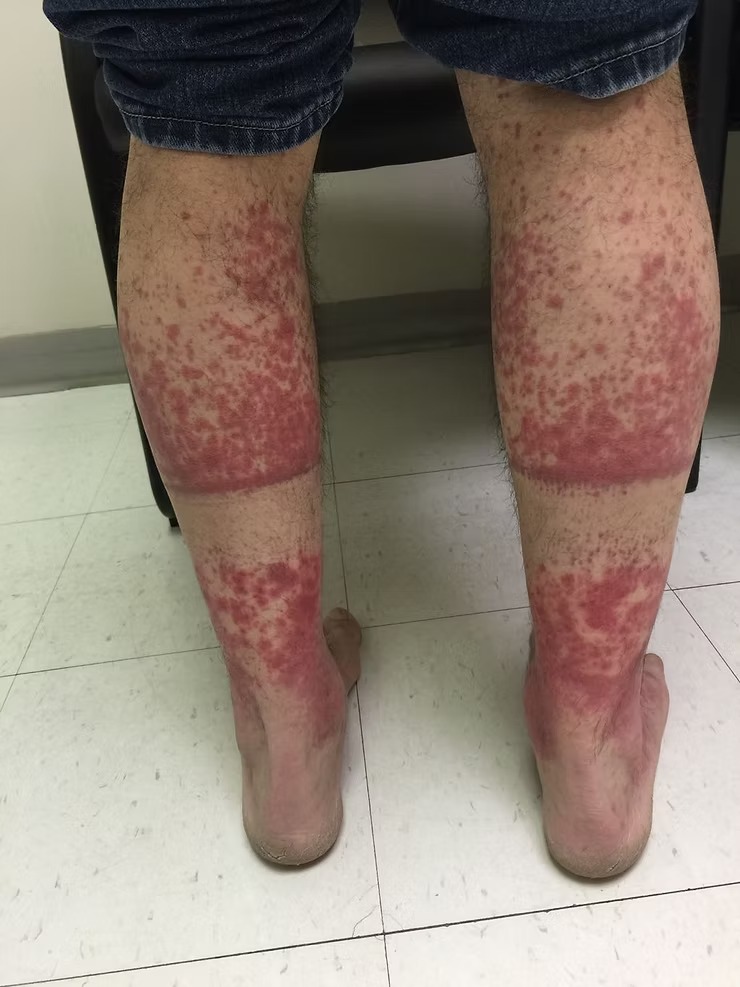Introduction
Imagine spending a warm afternoon outdoors—walking through a scenic park, exploring a vacation destination, or standing for hours at an outdoor event. The day feels pleasant, but later you notice an unexpected rash on your legs. At first glance, it might resemble sunburn, bug bites, or an allergic reaction. For many, the sight of reddish or purplish patches along the calves or ankles is confusing and concerning.
In many cases, this skin reaction is a sign of exercise-induced vasculitis (EIV), sometimes nicknamed golfer’s vasculitis, Disney rash, or hiker’s rash. While the name may sound intimidating, the condition is generally mild and temporary. Still, it often causes unnecessary worry because its appearance can resemble more serious medical issues.
This guide takes a detailed look at exercise-induced vasculitis—what it is, why it happens, who is most likely to experience it, and how you can manage or minimize flare-ups. By the end, you’ll understand that while the rash may be inconvenient, it is rarely dangerous and can usually be handled with simple self-care measures.
What Exactly Is Exercise-Induced Vasculitis?
Exercise-induced vasculitis is a condition that develops when the small blood vessels near the surface of the skin, particularly in the lower legs, become inflamed after extended periods of physical activity in hot or humid conditions.
Normally, during exercise, blood circulation increases to help regulate body temperature. However, in some individuals, blood doesn’t flow back to the heart efficiently and instead pools in the lower extremities. This pooling places stress on the delicate capillaries, causing inflammation and the appearance of a rash.
Typical Characteristics of the Rash
- Appears mainly on the calves, ankles, or shins
- Sometimes extends up toward the thighs
- Develops a few hours after prolonged walking, running, or standing in heat
- Reddish, purple, or blotchy patches that may be itchy or mildly uncomfortable
- Usually fades within 7–10 days once activity stops and the body cools down
Interestingly, EIV is often reported by cruise ship passengers who spend long days exploring hot, humid destinations on foot. They may assume the rash is an allergic reaction, only to later learn it is a harmless vascular response to exertion in warm weather.
Who Is More Likely to Experience It?
Although anyone can develop exercise-induced vasculitis, certain groups are more prone to flare-ups.
- Adults over 50: Circulation changes with age, making older adults more susceptible.
- Women: Active women, particularly those who walk long distances, seem to experience EIV more frequently.
- People exposed to prolonged outdoor activity in warm climates: Hikers, runners, golfers, and travelers often encounter it.
- Cruise and theme park visitors: Continuous walking in hot, humid weather makes these environments common triggers.
The condition is not considered rare, but it is often underrecognized because people mistake it for something else.
Common Symptoms
The symptoms of exercise-induced vasculitis can vary in intensity, but the most frequent signs include:
- Skin rash – Red, purple, or blotchy spots concentrated around the lower legs.
- Itching or burning sensation – The rash may feel irritated.
- Mild swelling – Particularly around the ankles or calves.
- Discomfort when walking – Rare, but some individuals feel heaviness in the legs.
These symptoms usually begin after several hours of activity in warm conditions. Most importantly, the rash tends to improve once the person rests, elevates the legs, and cools down.
Is It Dangerous?
For most people, exercise-induced vasculitis is not harmful. It resolves naturally and doesn’t cause long-term damage. The primary concerns are:
- Cosmetic (the rash may look alarming)
- Temporary discomfort (itching or burning)
The main risk lies in misidentification. Because EIV can mimic more serious conditions, people sometimes worry unnecessarily or, conversely, dismiss warning signs that require medical attention.
Home Remedies and Relief Strategies
Managing exercise-induced vasculitis usually involves simple lifestyle adjustments.
Helpful Approaches
- Cool Compresses: Place a damp, clean cloth on the rash to reduce irritation. Avoid placing ice directly on the skin.
- Elevating the Legs: Lying down with legs raised above heart level encourages blood circulation and reduces swelling.
- Hydration: Drinking plenty of water supports vascular health and helps prevent worsening symptoms.
- Over-the-Counter Antihistamines: Some people find relief from itching by using mild antihistamines.
Things to Avoid
Certain actions may worsen symptoms:
- Sitting in hot tubs or taking hot baths
- Prolonged exposure to direct sunlight
- Continuing strenuous exercise in high heat
- Massaging or rubbing the rash area
- Using topical muscle rubs (ineffective for this condition)
- Taking antibiotics unnecessarily (EIV is not caused by infection)
Can You Prevent It?
There is no guaranteed way to prevent exercise-induced vasculitis, but you can reduce your risk with practical steps:
- Modify Activity Timing: Plan outdoor exercise in the early morning or evening when temperatures are cooler.
- Dress Appropriately: Wear lightweight, breathable fabrics that allow heat to escape.
- Stay Hydrated: Drink fluids before and during physical activity.
- Take Breaks: Rest in shaded or air-conditioned areas to allow your body to recover.
- Compression Stockings: Some find relief wearing them, though they may feel uncomfortable in hot weather.
Conditions That May Look Similar
Because exercise-induced vasculitis creates a noticeable rash, it is sometimes confused with other medical problems. Here are some conditions to keep in mind:
- Cellulitis: A bacterial infection that usually affects one leg. Symptoms include redness, warmth, swelling, and sometimes fever. Requires antibiotics and medical attention.
- Folliculitis: Inflammation of hair follicles, often caused by bacteria or irritation. Appears as small red bumps or pustules.
- Meningitis: A medical emergency. One hallmark is a non-blanching rash (does not fade when pressed) combined with fever, severe headache, and illness.
- Sepsis: A life-threatening body-wide infection. Signs include pinpoint rashes, fever, chills, confusion, and rapid breathing.
- Measles: A contagious viral illness with flu-like symptoms followed by a widespread red rash.
While EIV is generally mild, seeking medical advice is always wise if symptoms seem unusual or severe.
When to See a Doctor
Most cases of exercise-induced vasculitis resolve on their own. However, consult a healthcare professional if:
- The rash spreads quickly or worsens
- It is painful, hot to touch, or accompanied by swelling
- You experience fever, chills, or flu-like symptoms
- You are uncertain whether it is EIV or another condition
Medical evaluation helps rule out more serious concerns.
Alternative Names for Exercise-Induced Vasculitis
EIV is known by several other names, often based on the environments where it appears:
- Golfer’s Vasculitis
- Disney Rash
- Hiker’s Rash
Regardless of the name, all describe the same process: small blood vessel inflammation triggered by physical exertion in warm weather.
Living with Exercise-Induced Vasculitis
For many, EIV is more of a nuisance than a health threat. With awareness and lifestyle adjustments, most people can continue enjoying physical activities.
Practical tips for daily life:
- Monitor weather conditions and plan activities during cooler times.
- Wear lightweight clothing and consider supportive footwear.
- Take breaks during long walks or hikes.
- Listen to your body—if symptoms appear, rest and cool down.
Frequently Asked Questions (FAQs)
1. Does exercise-induced vasculitis leave scars?
No, the rash typically fades without scarring once the inflammation resolves.
2. Can children get EIV?
It is uncommon in children. Most cases occur in middle-aged or older adults.
3. Will sunscreen prevent it?
Sunscreen protects against UV damage but does not prevent EIV, since it’s related to blood circulation, not sun exposure.
4. How long does it take to heal?
Most rashes fade within 7–10 days with rest and cooling measures.
5. Should I stop exercising?
Not necessarily. Instead, adjust timing, intensity, and environment to reduce the likelihood of recurrence.
Conclusion
Exercise-induced vasculitis may look dramatic, but in reality, it is usually a benign and temporary condition. It occurs when prolonged physical activity in hot weather causes inflammation of small blood vessels in the legs, producing a rash.
Understanding the difference between EIV and more serious conditions is key. Most cases improve with rest, hydration, and cooling strategies. However, always seek medical attention if symptoms worsen, spread rapidly, or come with fever or illness.
While there is no foolproof prevention, staying hydrated, choosing cooler times for exercise, and giving your body breaks can make a significant difference.
Ultimately, this condition is a reminder to listen to your body’s signals. Even minor symptoms, like a rash, can provide valuable insight into how your body responds to different environments and levels of exertion. With knowledge and awareness, you can continue to enjoy active lifestyles while keeping discomfort to a minimum.

